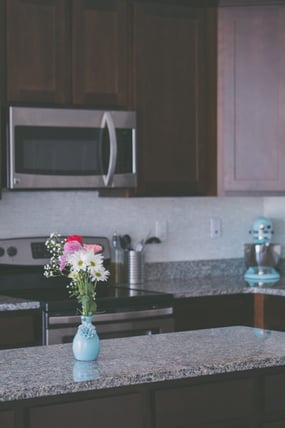Today, there are many different options for kitchen counters when building new homes or flipping older homes. Everything from natural stone to engineered stone to steel, wood, and even concrete have become ubiquitous. As a builder or investor, it’s worth knowing what the differences are between all of these options. Below is a list of common countertop materials on the market and a breakdown of each.
Quartz
Quartz has arguably become the most popular choice for residential kitchen counters in the last decade and there are several reasons for it. Quartz is an engineered stone, consisting of 95% crushed quartz and 5% resins, polymers, and adhesives, making it an extremely strong and durable material. It has an aesthetic comparable to granite with a slightly smoother, “cleaner” look and is about the same in terms of price range. Because they are engineered, quartz countertops are completely non-porous making them a very practical choice for kitchens. Quartz also comes in thousands of colors allowing for variety and color coordination, particularly appealing if you are building an open concept home. From a cost standpoint, quartz costs about $50-$70 per square foot.
Granite & Marble
Granite and marble countertops are 100% natural, quarried stones, prized for their beauty and high-end look. They are also quite durable and extremely resistant to heat. However, because they are porous - particularly marble - staining and excess moisture can damage or alter the look of the stone. For this reason, marble and granite also need to be sealed and maintained regularly.
It is worth noting that marble requires the most maintenance and is also the most expensive option, usually over $100 per square foot. One way to increase the sales price of your builds but keep costs low is to incorporate marble as an accent material. For example, quartz - which has the look of marble - can be used for surfaces that see constant daily use like countertops, and marble can be used for accent areas like a backsplash where there is much less contact with the stone.
Stainless Steel
Long a standard in professional restaurant kitchens, stainless steel countertops have been popular in residential applications for well over a decade. Stainless steel countertops are appealing because they are virtually indestructible. They are resistant to stains, heat, oils, and acid. This makes them not only durable but extremely practical as well. In terms of cost, however, stainless steel does tend to be the most expensive option per square foot, even out-pricing some natural stone. This material may be a good choice as an accent if you're building an industrial style loft for instance, as buyers would expect to see it there, but overall, it may not be the best choice financially to use on an entire kitchen.
When it comes to stainless steel, according to Countertop Investigator, “A new counter can cost anywhere from $100 up to $200 per sq. foot. For an average kitchen that has a counter that covers 30 ft.² in total the amount will be $3000 up to $6000. This estimate includes the cost of installation.”
Butcher Block
At the opposite end of stainless steel in terms of price, butcher block is a less expensive kitchen countertop option at an average of $20-$60 per square foot. Butcher block is a wood countertop made up of thin wooden strips which are glued together and sanded down. While this material creates a warm, rustic look, it does have its drawbacks. Butcher block stains easily, absorbs moisture, and must be sealed with mineral or walnut oil at least once a month.
Buyers tend to be aware of the maintenance requirements of butcher block, and you don't want to scare them away with a high maintenance material. However, because it is well priced, consider using butcher block in some areas of the kitchen and complimenting it with a warm colored, durable stone in areas that see a lot of use. For example, a bar or breakfast nook can feature butcher block, but areas around the stove, sink, or where chopping and meal prep happen can utilize stone.
Concrete
Concrete may not seem like an obvious choice for your construction or investment project but it does have its benefits. Firstly, the idea that it looks “rough” or “industrial” is a misconception. After the sanding and sealing process of concrete countertop installation, it has a warm finish, similar to that of natural stone, and is quite a strong, long lasting material. The price point of concrete is somewhere in the middle of all of the aforementioned options and it does require occasional sealing.
And while the cost of concrete itself is not the most expensive option, the installation process can be finicky and more costly than with pre-cut stone, wood, or steel. Consider this when deciding on countertops for your builds, especially if dealing with multi-unit. Is is probably more efficient and cost effective for you to use pre-cut stone or quartz, than having to hire additional tradespeople to pour concrete directly on site for multiple units.
Selecting the proper kitchen counters plays a huge role in the ability to sell a home. People spend a lot of time in their kitchens, so they need to be functional and easy to care for. The options we've listed above give builders a variety of materials to choose from that will suit a variety of styles and needs while taking into account what is the best value for the builder as well.

Recent Posts
- Spec Home Loans: Complete Guide to Construction Financing for Builders
- Spec Construction Loans: A Spec Line of Credit Is Worth the Paperwork
- Spec Homes and Pre-Sale Homes: Relative Benefits for a Spec Builder
- Spec Construction Success: Insights for the Investor Builder
- How Is a Spec House Different From Other Kinds of House Construction?
